
Acer saccharinum, commonly known as silver maple, creek maple, silverleaf maple, soft maple, large maple, water maple, swamp maple, or white maple, is a species of maple native to the eastern and central United States and southeastern Canada. It is one of the most common trees in the United States.

The Eurasian treecreeper or common treecreeper is a small passerine bird also known in the British Isles, where it is the only living member of its genus, simply as treecreeper. It is similar to other treecreepers, and has a curved bill, patterned brown upperparts, whitish underparts, and long stiff tail feathers which help it creep up tree trunks. It can be most easily distinguished from the similar short-toed treecreeper, which shares much of its European range, by its different song.
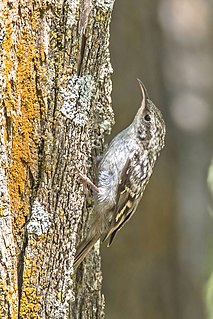
The short-toed treecreeper is a small passerine bird found in woodlands through much of the warmer regions of Europe and into north Africa. It has a generally more southerly distribution than the other European treecreeper species, the common treecreeper, with which it is easily confused where they both occur. The short-toed treecreeper tends to prefer deciduous trees and lower altitudes than its relative in these overlap areas. Although mainly sedentary, vagrants have occurred outside the breeding range.

The marmosets, also known as zaris or sagoin, are 22 New World monkey species of the genera Callithrix, Cebuella, Callibella, and Mico. All four genera are part of the biological family Callitrichidae. The term "marmoset" is also used in reference to Goeldi's marmoset, Callimico goeldii, which is closely related.

Spider monkeys are New World monkeys belonging to the genus Ateles, part of the subfamily Atelinae, family Atelidae. Like other atelines, they are found in tropical forests of Central and South America, from southern Mexico to Brazil. The genus contains seven species, all of which are under threat; the brown spider monkey is critically endangered. They are also notable for their ability to be easily bred in captivity.
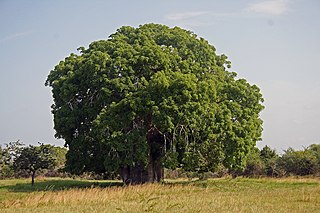
Adansonia is a genus made up of eight species of medium to large deciduous trees known as baobabs. Previously classified within the family Bombacaceae, they are now placed in the Malvaceae. They are native to Madagascar, mainland Africa and Australia. Trees have also been introduced to other regions such as Asia. The generic name honours Michel Adanson, the French naturalist and explorer who described Adansonia digitata. The baobab is also known as the "upside down tree", a name that originates from several myths. They are among the most long-lived of vascular plants and have large flowers that are reproductive for a maximum of 15 hours. The flowers open around dusk; opening so quickly that movement can be detected by the naked eye and are faded by the next morning. The fruits are large, oval to round and berry-like and hold kidney-shaped seeds in a dry, pulpy matrix.

Geoffroy's tamarin, also known as the Panamanian, red-crested or rufous-naped tamarin, is a tamarin, a type of small monkey, found in Panama and Colombia. It is predominantly black and white, with a reddish nape. Diurnal, Geoffroy's tamarin spends most of its time in trees, but does come down to the ground occasionally. It lives in groups that most often number between three and five individuals, and generally include one or more adults of each sex. It eats a variety of foods, including insects, exudates, fruits and other plant parts. Insects and fruits account for the majority of its diet, but exudates are also important. But since its teeth are not adapted for gouging trees to get to the sap, it can only eat exudates when they are easily available.
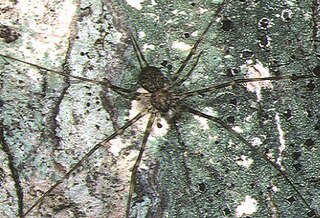
Hersiliidae is a tropical and subtropical family of spiders first described by Tamerlan Thorell in 1869, which are commonly known as tree trunk spiders. They have two prominent spinnerets that are almost as long as their abdomen, earning them another nickname, the "two-tailed spiders". They range in size from 10 to 18 mm long. Rather than using a web that captures prey directly, they lay a light coating of threads over an area of tree bark and wait for an insect to stray onto the patch. When this happens, they encircle their spinnerets around their prey while casting silk on it. When the insect is immobilized, they can bite it through the shroud.

Nephila is a genus of araneomorph spiders noted for the impressive webs they weave. Nephila consists of numerous species found in warmer regions around the world. They are commonly called golden silk orb-weavers, golden orb-weavers, giant wood spiders, or banana spiders.

Geoffroy's spider monkey, also known as the black-handed spider monkey or the Central American spider monkey is a species of spider monkey, a type of New World monkey, from Central America, parts of Mexico and possibly a small portion of Colombia. There are at least five subspecies. Some primatologists classify the black-headed spider monkey, found in Panama, Colombia, and Ecuador as the same species as Geoffroy's spider monkey.

The Peruvian spider monkey also known as the black-faced black spider monkey, is a species of spider monkey that lives in Peru, as well as in Brazil and in Bolivia. At 60 centimetres long, they are relatively large among species of monkey, and their strong, prehensile tails can be up to 1 m (3 ft) long. Unlike many species of monkey, they have only a vestigial thumb, an adaptation which enables them to travel using brachiation. Peruvian spider monkeys live in groups of 20–30 individuals, but these groups are rarely all together simultaneously. The size and dynamics of the resulting subgroups vary with food availability and sociobehavioral activity. They prefer to eat fleshy fruit, but will change their diet in response to scarcity of ripe fruit. Individuals of this species also eat small animals, insects and leaves based on availability. Females separate from the band to give birth, typically in the fall. These females inhabit a group of core areas where resources are abundant in certain seasons. Typically, males exhibit ranging over longer distances than females, with movement of individuals enhancing the fluidity of subgroup size. Peruvian spider monkey are independent at about 10 months, with a lifespan of about 20 years.

Hersilia, also known as long-spinnered bark spiders and two-tailed spiders, is a genus of tree trunk spiders that was first described by Jean Victoire Audouin in 1826. Their nicknames are a reference to their greatly enlarged spinnerets.
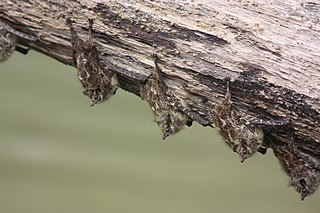
The proboscis bat is a bat species from South and Central America. Other common names include Long-nosed proboscis bat, sharp-nosed bat, Brazilian long-nosed bat and river bat in English, and murciélago narizón in Spanish. It is monotypic within its genus.

The Pseudostigmatidae are a family of tropical damselflies, known as helicopter damselflies, giant damselflies, or forest giants. The family includes the largest of all damselfly species. They specialize in preying on web-building spiders, and breed in phytotelmata, the small bodies of water held by plants such as bromeliads.

The Woodlark cuscus is a species of marsupial in the family Phalangeridae endemic to Papua New Guinea, specifically on Madau and Woodlark Island, a part of the Milne Bay Province of Papua New Guinea. It happens to be the largest mammal living on Woodlark Island but it is also found on the neighboring island of Alcester, 70 kilometers south of Woodlark Island.

Jalmenus evagoras, the imperial hairstreak, imperial blue, or common imperial blue, is a small, metallic blue butterfly of the family Lycaenidae. It is commonly found in eastern coastal regions of Australia. This species is notable for its unique mutualism with ants of the genus Iridomyrmex. The ants provide protection for juveniles and cues for adult mating behavior. They are compensated with food secreted from J. evagoras larvae. The ants greatly enhance the survival and reproductive success of the butterflies. J. evagoras lives and feeds on Acacia plants, so butterfly populations are localized to areas with preferred species of both host plants and ants.
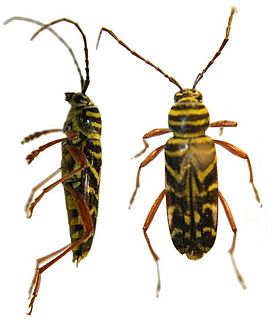
Megacyllene robiniae, commonly known as the locust borer, is a species of longhorn beetle endemic to eastern North America. It is a serious pest of Robinia pseudoacacia, the black locust tree, with which it is sympatric.

Ornithodoros savignyi, known as sand tampan, African eyed tampan or Kalahari sand tampan, is one of some 37 species in the genus Ornithodoros and is a soft tick with a leathery, mammillated integument, causing paralysis and tampan toxicosis, two unrelated conditions. The sand tampan is an ectoparasite on humans, their livestock and wild animals, including birds and bats. Occurring in semi-desert areas of Africa, Saudi Arabia and other parts of the Persian Gulf, India, Sri Lanka and into Asia, it is able to survive for lengthy periods without feeding, spending most of its life burrowed under sand or loose soil, often in wait for animals that rest or sleep under trees or in the lee of rocks, but also in places where people or their animals congregate such as marketplaces, places of worship, cattle kraals and village squares. The timing of its activity is geared to coincide with that of potential hosts, but hot sunny conditions are usually avoided. Because of its habit of feeding and dropping from its host, adult dispersal is limited, whereas larvae may remain attached to their hosts for several days. During its life cycle it will feed on multiple hosts between moults.

Hyllus semicupreus, the heavy-bodied jumper, also known as the semi-coppered heavy jumper, is a species of spider of the genus Hyllus. It is native to India and Sri Lanka.

Cryphoeca silvicola is a small species of dwarf sheet spider in the family Cybaeidae which has a Palearctic distribution. The generic name, Cryphoeca, means hidden and the specific name silvicola means "living in the woods".





















